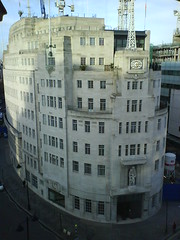 While everyone else in the world was watching events in Washington yesterday, I was in a posh hotel room working on something that’s as-yet unannounced. From room 641 you get a nice view of BBC Broadcasting House. I love it when work gets me through doors and to see stuff I’d never normally be allowed.
While everyone else in the world was watching events in Washington yesterday, I was in a posh hotel room working on something that’s as-yet unannounced. From room 641 you get a nice view of BBC Broadcasting House. I love it when work gets me through doors and to see stuff I’d never normally be allowed.The Victorian magnificence of the Langham hotel is being refurbished in even grander style; our cabs were much confused by having to drop off / pick up from the makeshift entrance round the south. The place has a fascinating history, though I’m most excited by its time as extended offices for the BBC.
“The ballroom became the BBC record library and programs [sic] such as The Goon Show were recorded there.”It’s also where those first early meetings were held to create some silly old TV show.Wikipedia, Langham Hotel, London, as of 21 January 2009.
Portland Place, on which these two buildings stand, gets its name from the white stone from Jurassic-era Dorset that’s so prevalent in London’s buildings. The subject of my efforts yesterday was impressed I knew why it’s so prevalent.
“In the years following the Industrial Revolution, the acid rain, resulting from the heavy burning of coal in cities had the effect of continuously (slightly) dissolving the surface of Portland stone ashlar on buildings. This had the interesting effect of keeping exposed and rain-washed surfaces white as opposed to other (non calcareous) stones which quickly discoloured to black in the smoky atmospheres. This self-cleaning property also helped to enhance the popularity of Portland stone in London.”Well, I say “impressed”; he didn’t run out of the room screaming.Mark Godden, “Portland's Quarries and its Stone”, Mark Godden’s Little Bit of Cyberspace Mk II, 2007.
Someone was talking about Portland stone last night, what was it ... oh yes, on "What the Victorians Did For Us." I think it had to do with loos.
ReplyDelete